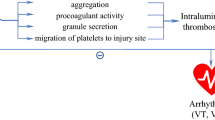Abstract
We have shown earlier that prostacylin (PGI2) and its stable analogue: 7-oxo-prostacyclin(7-OXO) may induce a prolonged, late appearing (24–48 h after drug administration), dose dependent protection of the heart from harmful consequences of a subsequent severe ischaemic stress, such as myocardial ischaemia, life-threatening ventricular arrhythmias and early ischaemic morphological changes. In an other study we observed that a similar but shortlived (less than 1 h) cardioprotection, induced by ‘preconditioning’ brief coronary artery occlusions, is greatly reduced by blockade of the cyclooxygenase pathway, suggesting that prostanoids might play a role in this shortlasting protection.
Objective of our present study was to elucidate the importance of some arachidonic acid (AA) metabolites, such as PGI2 and thromboxane A2 (TXA2) in the mechanism of the late appearing, prolonged cardioprotection. Estimation of the metabolites: 6-keto-PGF1α (6-KETO) and thromboxane B2 (TXB2) was made from the perfusate of isolated Langendorff hearts of guinea-pigs pretreated with 50 μg/kg 7-OXO, 24 and 48 h before preparation. Pretreatment alone produced a slight, but significant elevation of 6-KETO (from 206±11 to 284±19 pg/ml/min after 24 h, and to 261±18 pg/ml/min after 48 h). No change was seen in TXB2 production. Global ischaemia for 25 min (followed by 25 min reperfusion) markedly increased the release of both AA metabolites; maximal values were observed in the third min of reperfusion (6-KETO from 206±11 to 1275±55 pg/ml/min and TXB2 from 29±4 to 172±12 pg/ml/min). All values returned to the preischaemic level by the 25th min of reperfusion. Ischaemic increase in 6-KETO level was significantly higher in the perfusate of hearts from pretreated animals (1507±73 pg/ml/min after 24 h, and 1398±54 pg/ml/min after 48 h) that in those of untreated controls. There was no difference in TXB2 values. Thus both basal and ischaemic release of PGI2 increased 24 and 48 h after pretreatment with 7-OXO but not TXA2 production. Results suggest that endogenous prostanoids might play a role in late appearing cardioprotection.
Similar content being viewed by others
References
Murry CE, Jennings RB, Reimer KA: Preconditioning with ischaemia: A delay of lethal cell injury in ischaemic myocardium. Circulation 74: 1124–1136, 1986
Komori S, Parratt JR, Szekeres L, Végh Á: Preconditioning reduces the severity of ischaemia and reperfusion-induced arrhythmias in both anaesthetized rats and dogs. J Physiol Lond 423: 16p, 1990
Végh Á, Komori S, Szekeres L, Parratt JR: Antiarrhythmic effects of preconditioning in anaesthetised dogs and rats. Cardiovasc Res 26: 487–495, 1992
Végh Á, Szekeres L, Parratt JR: Protective effects of preconditioning of the ischaemic myocardium involve cyclo-oxygenase products. Cardiovasc Res 24: 1020–1023, 1990
Szekeres L, Krassói I, Udvary É: Delayed antiischaemic effect of PgI2 and of a new stable PgI2 analogue: 7-oxo-Prostacyclin-Na in experimental model angina in dogs. J Mol Cell Cardiol 15: Suppl I, 394, 1983
Szekeres L, Pataricza J, Szilvássy Z, Udvary É, Végh Á: Cardioprotection: Endogenous protective mechanism promoted by prostacyclin. In: RG Gülch, G Kissling (eds.) Current Topics in Heart Failure. Steinkopff Verl. Darmstadt. Basic Res Card 86: Suppl 3: 215–221, 1991
Coker SJ, Parratt JR, Ledingham IMcA, Zeitlin IJ: Thromboxane and prostacyclin release from ischaemic myocardium in relation to arrhythmias. Nature 291: 323–324, 1981
Coker SJ, Parratt JR, Ledingham IMcA, Zeitlin IJ: Aspirin inhibits the early myocardial release of thromboxane B2 and ventricular ectopic activity following acute coronary artery occlusion in dogs. Br J Pharmacol 72: 593–595, 1981
Coker SJ, Parratt JR: Effects of dazoxiben on arrhythmias and ventricular fibrillation induced by coronary artery occlusion and reperfusion in anaesthetised greyhounds. Br J Clin Pharmacol 15: 87–96, 1983
Coker SJ, Parratt JR: The effects of nafazatrom on arrhythmias and prostanoid release during coronary artery occlusion and reperfusion in anaesthetised greyhounds. J Mol Cell Cardiol 16: 43–52, 1984
Author information
Authors and Affiliations
Rights and permissions
About this article
Cite this article
Szekeres, L., Tósaki, Á. Release of 6-KETO-PGF1α and thromboxane B2 in late appearing cardioprotection induced by the stable PGI analogue: 7-OXO-PGI. Mol Cell Biochem 119, 129–132 (1993). https://doi.org/10.1007/BF00926863
Issue Date:
DOI: https://doi.org/10.1007/BF00926863




